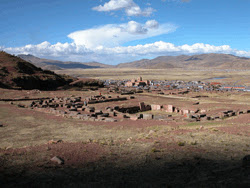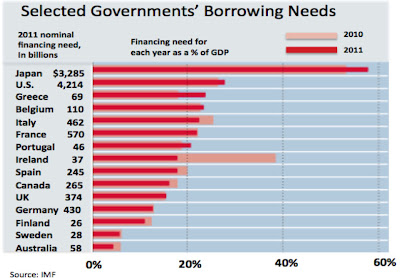TOP 10 DISCOVERIES OF 2011
By Archaeology Magazine, Volume 65 Number 1, January/February 2012 Issue.
Years from now, when we look back on 2011, the year will almost certainly be defined by political and economic upheaval. At the same time that Western nations were shaken by a global economic slump, people in the Middle East and North Africa forcefully removed heads of state who had been in power for decades. “Arab Spring,” as the various revolutions have collectively been named, will have far-reaching implications, not just for the societies in which it took place, but also for archaeology. No year-end review would be complete without polling archaeological communities in the affected areas to determine whether sites linked to the world’s oldest civilizations, from Apamea in Syria to Saqqara in Egypt, are still intact.
Of course, traditional fieldwork took place in 2011 as well. Archaeologists uncovered one of the world’s first buildings in Jordan. In Guatemala, a Maya tomb offered rare evidence of a female ruler, and, in Scotland, a boat was found with a 1,000-year-old Viking buried inside.
We also witnessed the impact that technology continues to have on archaeology. Researchers used a ground-penetrating radar survey of the site of a Roman gladiator school to create a digital model of what it may once have looked like. And scientists studying an early hominid have taken their investigation online by tapping the scientific blogging community. The team is seeking help to determine if they have actually found a sample of fossilized skin that appears to be more than 2 million years old. These projects stand as clear evidence that as cultures around the world undergo sweeping changes, so too does the practice and process of archaeology.
[Note: The listing below is not in the particular order given]
1. Viking Boat Burial - Ardnamurchan, Scotland
by Kate Ravilious
 |
| An artist’s conception shows how the burial may have originally looked. (Sarah Paris) |
A spectacular Viking boat burial was uncovered this year on the coast of Ardnamurchan, a remote region of western Scotland, the first such burial to be found on the British mainland. The Viking, who is thought to have perished over 1,000 years ago, was most likely a high-ranking warrior. He was buried lying in a 16-foot-long boat, with artifacts including a sword with silver inlay on the hilt, a shield, a spear, an ax, and a drinking horn. “The level of preservation of the objects and the range of grave goods make this one of the most important Viking burials found in the U.K.,” says Colleen Batey, a Viking specialist from the University of Glasgow.
Although the location is isolated today, at the time of the burial, it was right on the main north-south seafaring route between Ireland and Norway. No Viking dwellings have been found in Ardnamurchan, but Vikings are known to have inhabited the nearby islands of the Hebrides. “We don’t know why they chose this location for the burial, but the Neolithic and Bronze Age burial mounds there may have made it an important place for them,” says Oliver Harris, project co-director from the University of Leicester. Isotope analysis of the Viking’s teeth may eventually help the scientists pin down where he was from.
2. Neolithic Community Centers - Wadi Faynan, Jordan
by Nikhil Swaminathan
 |
| (David Oliver, WF16 Excavation Project) |
The discovery of the remains of a 4,500-square-foot structure at the south Jordanian site of Wadi Faynan is helping redefine the purpose of architecture at the point in history when roving bands of hunter-gatherers transitioned to sedentary societies. Rather than characterizing early Neolithic settlements dating to nearly 12,000 years ago as residential clusters tied to the advent of agriculture, structures such as the tower at Jericho on the West Bank and Göbekli Tepe in southern Turkey suggest an initial stage of settlement where people coalesced around communal activities and rituals.
Add to that list the oval-shaped building at Wadi Faynan, known simply as O75. It dates to 11,700 years ago and, according to Bill Finlayson, director of the Council for British Research in the Levant, who led its excavation, “it appears to have been built by digging a pit and then lining the walls with a very strong mud mixture.” A floor was constructed from mud plaster and surrounded by two tiers of benches, three feet deep and one-and-a-half feet high, recalling an amphitheater. Postholes indicate that a roof covered a section of the structure.
Some finds, including mortars for grinding found in raised platforms at the structure’s center, suggest people of the time might have used the building as a venue to collectively process plants, such as barley and pistachio. O75 may have additionally offered a space for communal gatherings. “It could have been a locale where small groups of people were aggregating on a periodic basis,” says A. Nigel Goring-Morris, a prehistoric archaeologist at the Hebrew University of Jerusalem who was not involved in the excavation.
3. Open Source Australopithecus - Malapa, South Africa
by Zach Zorich
 |
| Mineral deposits found on the fossilized remains of Australopithecus sediba could be early human skin. (Courtesy Lee Berger and the University of the Witwatersrand) |
The 2.2-million-year-old fossils of Australopithecus sediba have been providing new insights into human evolution since they were discovered in South Africa’s Malapa Cave in 2010. But now scans of some of the fossils have revealed a thin layer of minerals that could be the remains of Australopithecus skin. To determine whether this is the case, Lee Berger, a paleoanthropologist at the University of the Witwatersrand in Johannesburg and lead researcher on the project, is taking a revolutionary step and making this research project open source.
Berger has enlisted John Hawks, a paleoanthropologist and blogger at the University of Wisconsin, to reach out to the online scientific community for input on how the research should be designed and to help analyze the “skin” samples. Because no one has ever found fossilized early hominid skin, Hawks says, there are no experts on the subject.
According to Hawks, the open-source approach will help the team avoid a common pitfall of early hominid research — the sometimes decades-long delay between a fossil’s discovery and the publication of scientists’ analysis of the find. The team will post project updates online to inform the community of its progress and address any issues that might arise before submitting the research to a peer-reviewed journal.
The project is starting to attract interest worldwide. Berger’s team is in discussions with Russian anthropologists who suggested comparing the Malapa samples to other specimens of fossilized skin. The team is also working with a mineralogist from the University of Oslo, in Norway, to find a way to examine the structure of the “skin” with an electron microscope. If the mineral layer does turn out to be preserved skin, it could provide information about A. sediba’s hair, pigmentation, and sweat glands. If the layer turns out to be something else, paleoanthropology may still have gained a new approach to research.
4. First Domesticated Dogs - Předmostí, Czech Republic
by Zach Zorich
 |
| One of three skulls of the earliest domesticated dogs found in Czech Republic. This one was buried with a mastodon bone in its mouth. (Courtesy Mietje Germonpre) |
Researchers have, until recently, thought that dog domestication occurred about 14,000 years ago. In 2011, the case for it taking place much earlier received a boost from sites across Eurasia. Mietje Germonpré, of Belgium’s Museum of Natural History, and a team of researchers published a paper describing three canid skulls that had many of the distinctive traits that separate domesticated dogs from their wolf ancestors, including a shorter, broader snout and a wider brain case. The skulls, which date to roughly 31,500 years ago, were part of a collection from the site of Předmostí, in Czech Republic. In addition, a separate research team found a dog skull at Razboinichya Cave in Siberia that was dated to 33,000 years ago. Both finds support a 2009 research paper published by Germonpré and her colleagues describing a 36,000-year-old dog skull found at Goyet in Belgium. Critics could write off the single dog skull from Goyet as an aberration. “When I received the results of the date I was really disappointed,” Germonpré said of the Goyet skull. “I thought no one would believe it. I couldn’t believe it.” But the evidence from all three sites now makes Germonpré’s case much stronger.
5. Rare Maya Female Ruler - Nakum, Guatemala
by Jessica Woodard
 |
| (Courtesy Wiesław Koszkul, the Nakum Archaeological Project) |
Surprisingly untouched by looters, a well-hidden burial chamber found at the archaeological site of Nakum in northeastern Guatemala may have been the tomb of a female ruler from the second or third century A.D. The eastern-facing tomb held a 1,300-year-old skeleton, a jade pectoral, and a decorated vessel in the Tikal Dancer style, among other items. Through a crack in the tomb's floor, archaeologists uncovered an even older tomb with female remains bearing two vessels atop the head, along with other, more precious items. The tomb's quality and location suggest it was a burial chamber for a royal lineage that lasted half a millennium.
6. Gladiator Gym Goes Virtual - Carnuntum, Austria
by Jessica Woodard
 |
| A virtual re-creation of the gladiator school found in Austria. (Courtesy the Ludwig Boltzmann Institute for Archaeological Prospection and Virtual Archaeology) |
Ground-penetrating radar (GPR) technology has allowed an international team of researchers from the Ludwig Boltzmann Institute for Archaeological Prospection and Virtual Archaeology (LBI-ArchPro) to both identify a ludus (gladiator school) at the Roman city of Carnuntum in Austria and bring it before the public in an unprecedented way. What was once a vibrant city of 50,000 residents is now the site of an immense archaeological park. The newly discovered fourth-century A.D. gladiator school, the fourth largest ever found in the world, located just west of the largest amphitheater outside of Rome, is a self-enclosed complex that includes an inner courtyard, circular training area, living quarters, and a cemetery. The high-resolution images collected from the GPR survey show an under-floor heating system, bathing area, and walking paths within the complex. With the improved GPR technology developed by LBI-ArchPro, a complete picture of gladiator life is starting to emerge. Digitally re-created images of the ludus allow visitors to see how the school fit into the city’s landscape, and it’s possible to view them on a smartphone by using the free Wikitude World Browser software.
7. Ancient Chinese Takeout - Shaanxi/Xinjiang, China
by Lauren Hilgers
 |
| A researcher samples the world's oldest soup, which is cloudy and green due to the bronze vessel it was stored in for more than 2,000 years. (M. Klein, 7Reasons, Imaginechina) |
Today, dog soup and millet noodles may be meals only an archaeologist could love. In two tombs at opposite ends of the country, archaeologists have found the remains of intriguing dishes, well preserved in bronze vessels and clay pots and buried with the dead. In a Warring States tomb in Shaanxi Province, one team found a soup containing what they believe to be dog bones. And in Subeixi Cemetery in Xinjiang, another group of archaeologists found 2,400-year-old intact noodles made of millet. With efforts to re-create the meals, archaeologists may soon be eating like the ancients.
8. War Begets State - Lake Titicaca, Peru
by Julian Smith
 |
| Archaeologists believe neighbors from the nearby settlement of Pukara (above) burned Taraco. (Courtesy Charles Stanish, Cotsen Institute of Archaeology at the University of California, Los Angeles) |
Near the northern end of Lake Titicaca in Peru, a team led by Charles Stanish of the University of California, Los Angeles, found evidence that warfare may have been critical in the formation of early states. The main line of evidence is a 38-yard-long layer of ash and debris in a high-status residential area of a settlement called Taraco, one of the two largest political centers in the region. The site-wide burn, dated to the first century A.D., was so intense it melted adobe walls and carbonized thatched roofs.
Taraco’s fortunes changed drastically after the fire. The production of high-quality pottery and obsidian artifacts plummeted, and residents shifted from building with fine stone to working in the fields. At the same time, the nearby settlement of Pukara took off, expanding its territory by at least 60 miles and showing characteristics of state-level societies such as urbanized settlements, a warrior class, and full-time craft specialists.
Put all that evidence together, and Stanish theorizes that Pukara attacked and destroyed its rival Taraco. After two millennia of coexistence, war had come to the Titicaca Basin — but instead of snuffing the early spark of civilization, it served as tinder. Cooperation between cultures can certainly be a path to success, but sometimes organized conflict can be a more efficient, logical way to acquire resources.
“The models of state formation that do not see warfare as a central key element do not have it right,” says Steve LeBlanc of Harvard University.
9. Atlantic Whaler Found in Pacific - French Frigate Shoals, Hawaii
by Samir S. Patel
 |
| (Courtesy the National Oceanic and Atmospheric Administration) |
America's whaling fleet expanded the country's global reach and transformed the economy of the Pacific in the 1800s. Very few wrecks of these vessels have ever been found, as they usually went down in deep water, far from shore. This year, federal marine archaeologists working at French Frigate Shoals in the Papahanaumokuakea Marine National Monument in Hawaii finally identified one — Two Brothers, a Nantucket whaler that sank in 1823. The discovery started with a 10-foot anchor, and also included three iron trypots in which blubber was rendered into oil, remnants of the ship's rigging, and another anchor. Two Brothers has a special place in literary history. It was the second ship led by hard-luck captain George Pollard Jr. His first was the Essex, which was rammed and sunk by a sperm whale, providing inspiration for Moby Dick. Oh, and the Essex crew, including Pollard, resorted to cannibalism while drifting and starving on the open ocean.
10. Arab Spring Impacts Archaeology - Libya/Egypt/Tunisia/Syria
by Mike Elkin
 |
| While claims were made that harm had come to sites in Libya, such as the Leptis Magna (above), the damage was negligible. (Rob Walker/Flickr) |
No discussion of the year 2011 can be complete without a reference to what's been termed Arab Spring. The political phenomenon has the potential to have an extraordinary impact on archaeology for years to come.
In Libya, a Russian journalist broadcast that thieves plundered the country's museums and NATO bombed the ancient Roman sites of Leptis Magna and Sabratha. At the end of September, a three-person team from Blue Shield, a nonprofit organization concerned with the protection of cultural heritage in areas of conflict, traveled to western Libya and found Leptis Magna untouched. The theater at Sabratha suffered minor bullet damage, but the rest of the site was fine. Rebels had entered Tripoli's National Museum, but only wrecked Qaddafi's old cars on display; museum staff had previously hidden or moved important artifacts. Overall, the Blue Shield report said, they found no evidence of organized looting at the museums or archaeological sites they visited. Nevertheless, there are still concerns.
“There is a lot of hearsay, but artifacts have been smuggled out of the country through Egypt,” says Ray Bondin, Malta's ambassador to UNESCO, who has worked with Libyan heritage authorities for many years. “The sites are not well protected and the department of antiquities is still organizing itself.”
After rebels drove Qaddafi's forces from Benghazi, for instance, the so-called Treasure of Benghazi — around 8,000 bronze, silver, and gold coins and other artifacts from the ancient city of Cyrene near modern-day al-Bayda — disappeared from a bank vault.
Egypt appears to have been affected more than its westerly neighbor. After the revolution erupted in late January, then Minister of State for Antiquities Affairs Zahi Hawass offered assurances that all sites and artifacts were safe. Later, however, this proved not to be true. Looters had attacked dozens of sites and broke into storerooms throughout the country, including in the delta region, Abydos, Abu Sir, Giza, Dashur, Lisht, Saqqara, and Quntara. Thieves also pilfered artifacts from Cairo's Egyptian Museum, while protests and street battles went on outside in Tahrir Square.
Archaeologists in Egypt now say security has returned, but organization has faltered since the Mubarak regime fell. In an attempt to stabilize the situation, the Supreme Council of Antiquities (SCA) is no longer part of the Culture Ministry, and instead is part of Prime Minister Essam Sharaf's portfolio. “The SCA is going through a very painful auditing process,” says Tamar Teneishvili, a UNESCO specialist in Cairo. “And the treasury for cultural heritage management, funded by tourism, is empty.”
Tunisia, the first Arab Spring country to evict its dictator, appeared to have avoided post-uprising archaeological problems. Once Ben Ali and his family fled the country, however, an earlier, state-sponsored looting epidemic was discovered. On a program on France 2 television, Complément d'enquête, Fathi Bejaoui of Tunisia's National Heritage Institute was filmed as he entered Ben Ali's daughter's abandoned beach mansion. There they found nearly 200 artifacts used as decoration. Ancient columns held up a large exhaust hood in the kitchen and marble friezes were cut to frame the fireplace.
Syria could be the next country to oust a regime, but the government has sealed the country to outsiders and information is sparse. The state-run news agency reported in September 2011 that looters had hit the Seleucid city Apamea, not far from modern-day Hama, the seat of opposition to the Assad regime.
[Source: Archaeology Magazine]





























